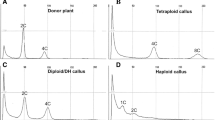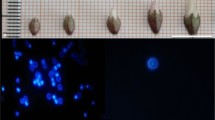Abstract
Haploids are important for studying plant breeding and genome sequencing. Regeneration from in vitro anther culture under aseptic conditions has achieved success in many higher plants. This study focused on anther culture of hardy kiwifruit (Actinidia arguta Planch.) to obtain haploid or double haploid plants that originated from microspores. Using the anthers of hardy kiwifruit as the test materials, we report the relationship between the microspore development stage and the bud morphological characteristics, some factors influenced the callus induction and the differentiation of the adventitious buds. The results showed that microspore development correlated with the bud diameter and morphological characteristics during development. The microspore development stage, pretreatment at low temperature (4 °C), basic medium, plant growth regulators and genotype all affect hardy kiwifruit anther callus induction, and the type and concentration of plant growth regulators significantly affect the regeneration of adventitious buds. The ploidy of 119 regenerated plants was verified using flow cytometry. The results showed that the ploidy of the plantlets obtained from the vitro anther culture of hardy kiwifruit was complex, being 3.36% haploid, 56.3% tetraploid, 4.20% hexaploid, and 36.13% octoploid.







Similar content being viewed by others
Abbreviations
- 2,4-D:
-
2,4-Dichlorophenoxyacetic acid
- 6-BA:
-
6-Benzylaminopurine
- KT:
-
Kinetin
- NAA:
-
α-Naphthaleneacetic acid
- IBA:
-
Indole-3-butyric acid
- ZT:
-
Zeatin
- TDZ:
-
Thidiazuron
- 2-ip:
-
z-IP
References
Achar PN (2002) A study of factors affecting embryo yields from anther culture of cabbage. Plant Cell Tissue Organ Cult 69:183–188
Ball ST, Zhou HP, Konzak CF (1993) Influence of 2,4-D, IAA, and duration of callus induction in anther cultures of spring wheat. Plant Sci 90:195–200
Baranec T, Murín A (2003) Karyological analyses of some Korean woody plants. Biologia 58:797–804
Blasco M, Badenes ML, Naval MDM (2015) Colchicine-induced polyploidy in loquat (Eriobotrya japonica. (Thunb.) Lindl.). Plant Cell Tissue Organ Cult 120:453–461
Coimbra S, Torrão L, Abreu I (2004) Programmed cell death induces male sterility in Actinidia deliciosa female flowers. Plant Physiol Biochem 42:537–541
Datta SK (2005) Androgenic haploids: factors controlling development and its application in crop improvement. Curr Sci 89:1870–1878
Doi H, Takahashi R, Hikage T, Takahata Y (2010) Embryogenesis and doubled haploid production from anther culture in gentian (Gentiana triflora). Plant Cell Tissue Organ Cult 102:27–33
Dunwell JM (2010) Haploids in flowering plants: origins and exploitation. Plant Biotechnol J 8:377–424
Dwivedi SL, Britt AB, Tripathi L, Sharma S, Upadhyaya HD, Ortiz R (2015) Haploids: constraints and opportunities in plant breeding. Biotechnol Adv 33:812–829
Fraser LG, Harvey CF (1986) Somatic embryogenesis from anther-derived callus in two Actinidia species. Sci Hortic 29:335–346
Gamborg OL, Miller RA, Ojima K (1968) Nutrient requirements of suspension cultures of soybean root cells. Exp Cell Res 50:151–158
Germanà MA (2006) Doubled haploid production in fruit crops. Plant Cell Tissue Organ Cult 86:131–146
Germanà MA (2011a) Anther culture for haploid and doubled haploid production. Plant Cell Tissue Organ Cult 104:283–300
Germanà MA (2011b) Gametic embryogenesis and haploid technology as valuable support to plant breeding. Plant Cell Rep 30:839–857
Gong WH, Li ZQ, Li HY (2005) Evaluation of excellent resources of Actinidia chinensis in China. Shanxi Fruits 5:23–24
Jia Y, Zhang QX, Pan HT, Wang SQ, Liu QL, Sun LX (2014) Callus induction and haploid plant regeneration from baby primrose (Primula forbesii Franch.) anther culture. Sci Hortic 176:273–281
Kataoka I, Mizugami T, Kim JG, Beppu K, Fukuda T, Sugahara S, Tanaka K, Satoh H, Tozawa K (2010) Ploidy variation of hardy kiwifruit (Actinidia arguta) resources and geographic distribution in Japan. Sci Hortic 124:409–414
Kim KM, Baenziger PS, Rybczynski JJ, Arumuganathan K (2003) Characterization of ploidy levels of wheat microspore-derived plants using laser flow cytometry. In Vitro Cell Dev Biol Plant 39:663–668
Kim JG, Beppu K, Kataoka I (2009) Varietal differences in phenolic content and astringency in skin and flesh of hardy kiwifruit resources in Japan. Sci Hortic 120:551–554
Kozak K, Galek R, Waheed MT, Sawicka-Sienkiewicz E (2012) Anther culture of Lupinus angustifolius: callus formation and the development of multicellular and embryo-like structures. Plant Growth Regul 66:145–153
Krupa T, Latocha P, Liwińska A (2011) Changes of physicochemical quality, phenolics and vitamin C content in hardy kiwifruit (Actinidia arguta and its hybrid) during storage. Sci Hortic 130:410–417
Latocha P, Krupa T (2008) The mineral composition of new genotypes of hardy kiwifruit (Actinidia Lindl.) bred at SGGW. Ann Warsaw Univ Life Sci–SGGW, Hortic Landscape Archit 29:105–110
Latocha P, Olszewska-Kaczyńska I (2003) Preliminary morphological, chemicaland sensory analyses of fruit of different actinidia genotypes (Actinidia Lindl.). Ann Warsaw Univ Life Sci–SGGW, Hortic Landscape Archit 24:51–56
Lei XJ (2013) Anther and hybrid embryo culture in Panax ginseng C. A. Mey and the characteristic evaluation based on ginsenoside content. Dissertation, Chinese Academy of Agricultural Sciences
Li S, Li W (2008) Principles and techniques of plant tissue culture. Chemical Industry Press, Beijing
Li JY, Wu W, Guo YJ, He XH, Chen JW (2013a) Correlation of cytological development period and morphological characteristics of flower organ of Angelica dahurica. Chin Agric Sci Bull 29:151–154
Li YF, Wang RT, Yuan CQ, Zhao KQ, Sun YH, Li Y, Zhang KY (2013b) Optimal anther culture period and flower bud selecting standard for Robinia pseudoacacia var. decaisneana (Carr.) voss. J Northwest A&F Univ 41:65–71
Li ZZ, Man Y-P, Lan XY, Wang YC (2013c) Ploidy and phenotype variation of a natural Actnidia arguta populationin the east of Daba Mountain located in a region of Shaanxi. Sci Hortic 161:259–265
Lloyd GB, McCown BH (1980) Commercially feasible micro-propagation of mountain laurel (Kalmia latifolia) by use of shoot tip culture. Proc Int Plant Propagators Soc 30:421–437
Maraschin SF, Priester WD, Spaink HP, Wang M (2005) Androgenic switch: an example of plant embryogenesis from the male gametophyte perspective. J Exp Bot 56:1711–1726
Mulinacci N, Giaccherini C, Santamaria AR, Caniato R, Ferrari F, Valletta A, Pasqua G (2008) Anthocyanins and xanthones in the calli and regenerated shoots of Hypericum perforatum var. angustifolium (sin. fröhlich) borkh. Plant Physiol Biochem 46:414–420
Murashige T, Skoog F (1962) A revised medium for rapid growth and bioassays with tobacco tissue culture. Physiol Plant 15:472–497
Nishiyama I, Fukuda T, Oota T (2005) Genotypic differences in chlorophy ll, lutein and β-carotene content in the fruit of Actinidia species. J Agric Food Chem 53:6403–6407
Niu YF, Peng JY, Li L (2011) Morphology of flower organ and anatomical characteristics of microspore different developmental period in Chinese jujube and wild jujube. J Plant Genet Resour 12:158–162
Paulraj S, Lopez-Villalobos A, Yeung EC (2014) Abscisic acid promotes shoot regeneration in Arabidopsis zygotic embryo explants. In Vitro Cell Dev Plant 50:627–637
Pechan PM, Smykal P (2001) Androgenesis: affecting the fate of the male gametophyte. Physiol Plant 111:1–8
Phivnil K, Beppu K, Takamura T, Fukuda T, Kataoka I (2005) Flow cytometric assessment of ploidy in native resources of Actinidia in Japan. J Am Pom Soc 59:44–49
Rimberia FK, Adaniya S, Ishimine Y, Etoh T (2009) Variation in ploidy and morphology among anther-derived papaya plants. Acta Hort 829:375–381
Scoccianti V, Speranza A, Crinelli R, Calzoni GL, Biasi R, Altamura MM, Bagni N (1999) Development-related changes of protein ubiquitination in pollen from male and female kiwifruit (Actinidia deliciosa). Physiol Plant 107:128–135
Shariatpanahi ME, Bal U, Heberlebors E, Touraev A (2006) Stresses applied for the re-programming of plant microspores towards in vitro embryogenesis. Physiol Plant 127:519–534
Shi QH, Liu P, Liu MJ (2012) Advances in ploidy breeding of fruit trees. Acta Hortic Sin 39:1639–1654
Silvestri C, Cristofori V, Ceccarelli M, Caceres ME, Escribà Lacuesta J, Rugini E (2016) Adventitious shoot organogenesis from leaf and petiole explants of European hazelnut. Plant Cell Tissue Organ Cult 126:59–67
Touraev A, Pfosser M, Heberle-Bors E (2001) The microspore: a haploid multipurpose cell. Adv Bot Res 35:53–109
Wang LH, Zhang BX, Guo JZ, Yang GM, Du MZ (2004) Studies of effects of several factors on anther culture of Capsicum annuum L. Acta Hortic Sin 31:199–204
Wang WW, Yang XP, Fan SY, Liu G, Zhang M, Xu JH (2015) Correlation between microspore development period and floral organ morphology of Cucumis melo L.. J Northwest A&F Univ 43(4):108–112
Williams MH, Boyd LM, McNeilage MA, MacRae EA, Ferguson AR, Beatson RA, Martin PJ (2003) Development and commercialization of ‘Baby Kiwi’ Actinidia arguta Planch. Acta Hortic 610:8–16
Xie M, Qin LY, Pan JS, He HL, Wu AZ, Cai R (2005) Flower morphogenesis and microspore development versus anther culture of cucumber. Acta Bot Boreali-Occidentalia Sin 25:1096–1100
Xu YJ (2012) Studies on optimization of the regeneration and genetic transformation in Camellia sinensis (L.) O. Kuntze. Dissertation, Nanjing Agricultural University
Zhang JP, Gong ZH, Liu KK, Huang W, Li DW (2007). Interrelation of cytological development period of pepper’s microspore and the morphology of flower organ. J Northwest A&F Univ 35:153–158
Zhang SC, Wei AZ, Yang TX (2011a) Advances in the research and application of haploid and doubled haploid technologies in fruit trees. J Fruit Sci 28:869–874
Zhang X, Wu Q, Li X, Zheng S, Wang S, Guo L, Zhang L, Custers JBM (2011b) Haploid plant production in Zantedeschia aethiopica, ‘Hong Gan’ using anther culture. Sci Hortic 129:335–342
Zhao DD (2011) Studies on endosperm culture and ploidy variations of kiwifruit. Dissertation, Zhejiang University
Zheng XH (2008) Study on in vitro culture and plantlet regeneration with stem and leaf explants from Actinidia arguta Planch. Dissertation, Sichuan Agriculture University
Ziegler G, Dressler K, Hess D (1990) Investigations on the anther culturability of four German spring wheat cultivars and the influence of light on regeneration of green vs. albino plants. Plant Breed 105:40–46
Acknowledgements
This research was supported by the Project of Science and Technology Department of Jilin Province (#20170203006NY) and the Central Public-interest Scientific Institution Basal Research Fund (#1610342016019).
Author information
Authors and Affiliations
Contributions
Designed the experiments: HYQ and JA. Performed the experiments: GFW. Analysed the data: DS. Contributed reagents/materials/analysis tools: STF, YMY and ZXW. Checked and corrected the manuscript: PLX, YZ and YXL. Wrote the paper: GFW and HYQ. All co-authors agree on the contents of the final manuscript and approve it.
Corresponding author
Ethics declarations
Conflict of interest
The authors declare that they have no conflict of interest.
Additional information
Communicated by Sergio J. Ochatt.
Guang-Fu Wang and Hong-Yan Qin contributed equally to this study.
Rights and permissions
About this article
Cite this article
Wang, GF., Qin, HY., Sun, D. et al. Haploid plant regeneration from hardy kiwifruit (Actinidia arguta Planch.) anther culture. Plant Cell Tiss Organ Cult 134, 15–28 (2018). https://doi.org/10.1007/s11240-018-1396-7
Received:
Accepted:
Published:
Issue Date:
DOI: https://doi.org/10.1007/s11240-018-1396-7




